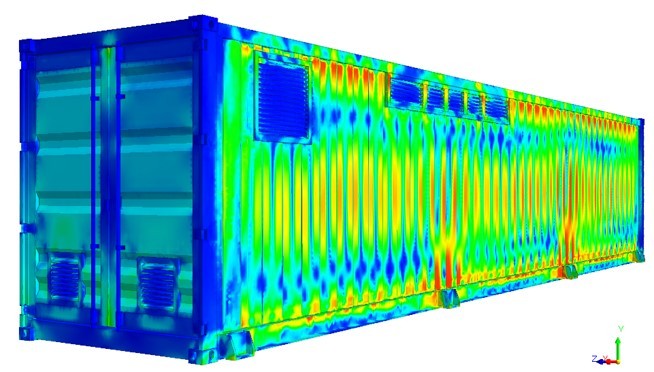Overview
In the process where renewable energy takes the spotlight, the need and interest in Energy Storage Systems (ESS) to secure electric energy from various sources persist. Achieving stable energy storage requires thorough verification during the ESS design phase, considering the environmental factors of its installation and potential issues arising during the setup. This pursuit of stability becomes paramount for ESS.
So, what are the key considerations in ESS design? Let's explore:
1. Heat Dissipation for Internal Heat Generation in ESS:
Conducting thermal analysis to appropriately disperse internal heat within the ESS is crucial. This involves verifying the effectiveness of cooling systems, such as examining cases where fans are used to facilitate airflow. Analyzing the results helps design a smooth airflow, ensuring a stable temperature distribution and preventing areas with excessive heat.
2. Structural Stability Evaluation During Seismic Events:
Assessing the structural stability of ESS during seismic events is imperative. Factors like snow loads and wind pressure need consideration. Moreover, evaluating structural stability concerning potential earthquakes is vital, requiring seismic assessments based on regional and standard-specific evaluations worldwide. Defining seismic loads and conducting stress analysis based on the results ensures stability within the elastic range of stress.
3. Evaluation of Vibrations and Deformations during ESS Transportation:
ESS units are sizable products, demanding evaluations for structural stability during transportation, especially when using vehicles for installation. Assessments should cover acceleration and deceleration during vehicle movement, as well as lifting the ESS during transportation.
Addressing these analysis issues during ESS design demands comprehensive simulations using tools like midas NFX:
- Thermal Analysis for Internal Heat Generation:
midas NFX facilitates analyzing temperature distribution due to internal heat and optimizing cooling systems, like fans, for efficient airflow.



-Structural Stability During Seismic Events:
Conducting stress analysis based on defined seismic loads to ensure the design's stability within the elastic stress range.


-Evaluation of Vibrations and Deformations during Transportation:
Assessing structural stability during vehicle movement and lifting processes for ESS transportation.

[Displacement when lifting the ESS container]
midas NFX streamlines these diverse analysis concerns into one platform, enabling structural and fluid analysis, providing convenience and high utility in ESS design.
list view




